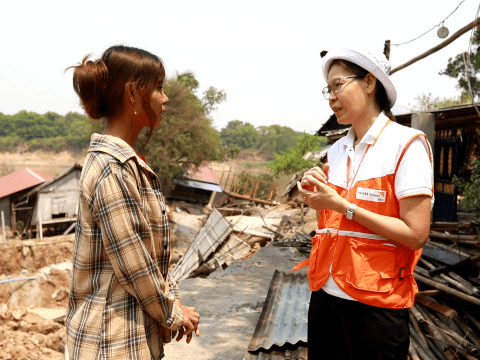Where do we start?

by Naw Phoebe, Advocacy and Communications Director, World Vision International Myanmar
I was outside having lunch when the ground under my feet shook violently. I wondered if I was feeling dizzy? But then I saw the buildings sway like a cradle and people running out, that is when I realized it was an earthquake. It was a scary feeling. Once things calmed down, I was able to process the magnitude. If the experience in Yangon was so overwhelming, then I could only imagine what it would be like for those in Mandalay, which was the epicentre of the earthquake. Frames and frames of destruction splashed across social media opened my eyes to the sheer magnitude of the earthquake.
Soon, I got the news that I was deployed to visit the area. Even days after the earthquake in central Myanmar, people in Mandalay were still fearing the aftershocks that recurred every day. The families dared not step inside the house as it made them relive the tragic moments when the earthquake hit. Homeless, they lined up on the roadside in front of their houses or nearby open spaces to spend the night. As I walked the streets, passing by dilapidated buildings, the smell of dead bodies buried under the rubble was hard to stomach. I increased my pace to get past quickly. A few steps away, I was accompanied by our field staff, Sar Eh from Tada-U, whose house was damaged by the earthquake. I listened intently as she narrated her experience.
"I was having lunch. Once I first felt the quake, I had no idea what had happened. But later, I ran out of the office and sat still on the road in front. When the first quake stopped, I went up to the office to grab my laptop and phone. That is when the second quake happened, and I felt like I was thrown into the air. Shaking with fear, instead of running out to the front, I ran to the back of the office and waited until the shaking stopped. The back fence was partially damaged, so I was able to crawl over to the compound next to the office and asked for help," she said.
Like Sar Eh, many homes were damaged, and thousands lost their homes. At night, I saw many families sleeping outside on the pavements. Sleeping outside leaves them exposed and unsafe. Such conditions could increase risks of violence & exploitation, especially for children. The children I spoke to talked about how scared they were of the aftershocks, as it reminded them of what they witnessed when the earthquake struck, including buildings collapsing in front of their eyes. Children were having nightmares when they slept at night.
In my 20 years working in the development sector, I hadn’t seen such levels of destruction and damage. Currently, more than 17 million people are living in areas affected by the earthquake.
In the hardest-hit areas, including Mandalay and Sagaing, entire communities have been forced to
shelter in makeshift conditions. Livelihoods have been disrupted. People don’t have access to
essential services like clean water and sanitation. As rains are anticipated and cases of diarrhoea rise in the earthquake-hit areas, I am concerned for the children who are sleeping in the open, with no proper shelter. All these conditions put them at serious risk.
Extreme heat of around 40 degrees Celsius added to the compounding challeges facing those affected by the earthquake. Survivors are at risk of skin infection due to insufficient water for domestic use. Women and girls do not have private space to shower and change cloths, which could put them at high risk of gender-based violence. Being a woman, I could understand the needs of women and girls, like sanitary napkins, panties, and mental support. There are some losses that cannot be seen, but they are psychologically in despair.
It will take a long time for the people affected by the earthquake to rebuild their lives, especially due to the detrimental damage to fields, irrigation, and grain stores.
As a humanitarian worker, I want to do my best to help the affected children and their families get back on their feet. The arms of service start with me.
Even before the earthquake, World Vision has been in Mandalay. As part of our humanitarian response efforts, World Vision is providing life-saving relief assistance to the children and their families affected by the earthquake. Through our humanitarian efforts, both immediate relief and long-term recovery, we aim to support 500,000 people, including 85,057 boys and 86,902 girls. As of 14 May 2025, we have reached 321,349 people affected by the earthquake, including 101,950 children.